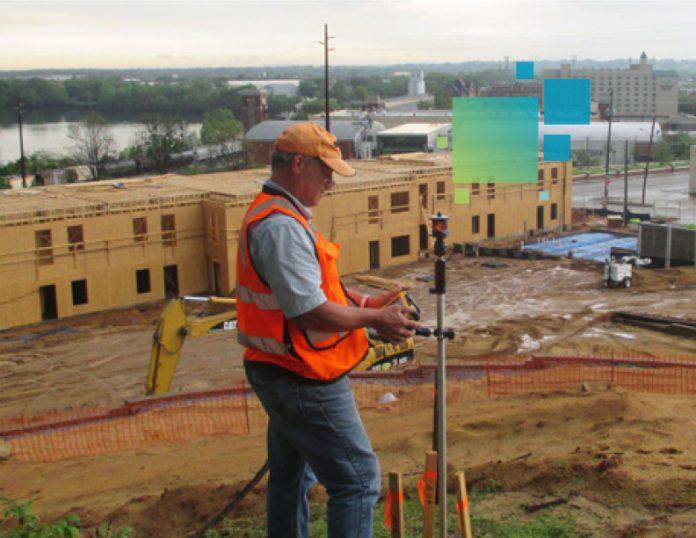Robotic total stations and intelligent field layout software are gaining in popularity because of their benefits, but as with any new technology, the associated costs and learning curve seem intimidating at first. Golden Construction in Birmingham, Ala., recently invested in the Leica iCON robots with surprising results. We sat down with Golden Construction’s Steven Denney, a veteran field engineer , to talk about some of the benefits his firm has experienced since adopting the use of robotic total stations in the field.
Was the move to robotic total stations difficult at Golden Construction?
SD: Sometimes there is hesitation about robotic total stations because there is always a fear of the unknown. But with the way the construction process is going, it seems like everyone who has taken on this new technology is seeing the benefit and not reverting back to manual instruments.
What do you think is the biggest benefit of using robotic total stations?
SD: The significant increase in productivity and more time available for checking work. If I can get through my task – whatever it is I have to layout – then that gives me more time to double check more work, which is a good thing. Less time involved in layout also means more time for other tasks.
RELATED: The Robotic Total Station Is a New Construction Technology That Offers Instant Value (The Golden Construction Blog)
Robotic total stations can be operated by one person – is that helpful?
SD: Yes. There are cost savings on labor and travel time and expenses – and if you feel the need to have a two-man crew, you don’t have to always rely on someone being as skilled to help you. Also, with the robotic instrument, both people – the trainer and the trainee – are standing side-by-side the entire time, so you don’t have that disconnect.
What about mistakes – does the robotic total station help prevent them?
SD: Not being stuck behind the instrument helps to prevent mistakes. You are always right there where the work is going, which is a huge benefit. And the accuracy is equal to any comparable manual total station.
How is productivity increased vs. with a manual instrument?
SD: With a one-man robotic instrument, you can record an average of 600-1,500 points in a day, depending on the terrain and variables. With a two-man manual station, you may only be able to record 250-400 points per day. In our experience, whatever a two-man manual station can do, one person with a robot can do twice as much, maybe even four times as much.
How did you convince management to invest in robotic total stations?
SD: One of the things I did initially – because I was very skeptical at first – was talk to people who were actually using these instruments in real world situations. I asked a local surveying firm what the robots could do. The guy said he actually sent two crews out on a job one day. One crew had a manual instrument, while the other crew was just one person using a robotic instrument. Both crews were working the same site, working together to record the terrain. He said the one man using a robotic instrument recorded roughly 1,500 points. The two-man crew using a manual instrument recorded around 400 points. That was a shock.
What other evidence did you present to get them to say yes?
SD: Initially, I had a local sales rep bring a robotic instrument out to the jobsite. I wanted to see what the robot could do compared to the crew using a manual instrument. We worked head-to-head to do a little demo that way. Also, just before our most recent purchase, I had another demo on the jobsite. The sales rep used the robotic instrument, while two guys from our company used the manual instrument. I recorded the whole thing on video and presented that video to management so they could see it for themselves.
What did they think?
SD: The superintendent on the project was there that day. Before the presentation, he was very skeptical and just didn’t understand why we would spend the extra money when everything was just fine the way it was. After it was all said and done and the sales rep left, he looked at me and said, “Man, we would be crazy not to buy one.”
Now that you have had the robotic total stations for a few months and have been using them on projects, have the ROI numbers held up?
SD: They have. We haven’t completely made the transition over from manual instruments to robotic instruments, though we are in the process of doing that. Right now, we have two manual instruments and two robots. I’ll get calls sometimes from one of the crews still using a manual instrument. They will want me to come over and record the information for them because they have recognized how fast the robot can do the work. There have been multiple examples of seeing the benefits. It has met and exceeded our expectations.
What about BIM? Do you see your move into robotic total stations as a preliminary step into BIM?
SD: Yes. We are slowly but surely getting more involved with BIM in our construction process. It can take hours and even days and weeks to decipher 2D drawings. The concept lives in the mind of the architect and the engineer and you are just trying to grasp it the best you can. By having a 3D model, it really helps paint the picture and gives everyone an understanding of what the building should look like, as well as having all of the information embedded so it can be quickly downloaded into your software.
Are your clients increasingly requesting BIM services?
SD: The more they learn about it, the more they want that information.
To learn more about how Golden Construction is transforming construction practices, watch this on-demand webinar with Steven Denney.








